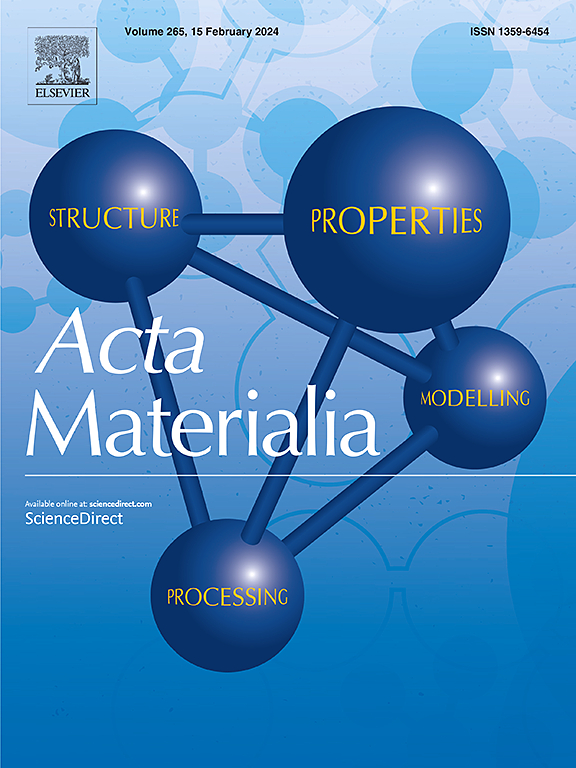Creep-induced elemental redistribution at grain boundaries of 304L stainless steel – An experimental evidence for diffusional creep mechanisms
IF 8.3
1区 材料科学
Q1 MATERIALS SCIENCE, MULTIDISCIPLINARY
引用次数: 0
Abstract
Seventy-five years ago, Nabarro and Herring—and subsequently, Coble—theorized Newtonian diffusional creep mechanisms in crystalline materials. They postulated that the deformation rate is governed by the flow of atoms along the direction of applied stress via a vacancy-atom exchange mechanism under diffusional creep conditions. These theories render a compelling picture for materials scientists to design microstructures with improved creep resistance. However, they remain vigorously debated due to a dearth of direct experimental evidence and poor predictions of the observed creep rates in certain materials and conditions. In this paper, we tested the hypothesis that, in alloys undergoing diffusional creep, elemental redistribution would manifest at nearby grain boundaries if the diffusivities of the alloying elements were significantly different. Furthermore, the extent of elemental redistribution would vary depending on the orientation of the grain boundary with respect to the tensile loading axis. To this end, 304L stainless steel alloy tensile specimens were crept under relatively low applied stresses (2.5-15 MPa) at 750°C. Chemical composition at the grain boundaries in the deformed and undeformed sections of the specimen were then compared and the trends were rationalized using thermodynamic and kinetic modeling. In support of our hypothesis, the results revealed a notable change in the nature and extent of creep-induced elemental redistribution (CIER). Our experimental observations of CIER, complemented with modeling results, suggested the occurrence of Newtonian diffusional creep. Further mechanistic understanding of diffusional creep via characterization and modeling of CIER is expected to make the approach more viable and enable new pathways for designing advanced creep-resistant materials for extreme environments.

蠕变诱导的304L不锈钢晶界元素重分布——扩散蠕变机制的实验证据
75年前,纳巴罗和赫林——以及后来的科布尔——提出了晶体材料中的牛顿扩散蠕变机制的理论。他们假设在扩散蠕变条件下,通过空位-原子交换机制,原子沿着施加应力的方向流动,从而控制变形速率。这些理论为材料科学家设计具有更好抗蠕变性能的微结构提供了一幅令人信服的图景。然而,由于缺乏直接的实验证据和对某些材料和条件下观察到的蠕变率的不良预测,它们仍然存在激烈的争论。在本文中,我们验证了这样一个假设,即在合金进行扩散蠕变时,如果合金元素的扩散系数有显著差异,则元素在晶界附近会出现重分布。此外,元素再分配的程度取决于相对于拉伸加载轴的晶界取向。为此,304L不锈钢合金拉伸试样在750℃下相对较低的外加应力(2.5-15 MPa)下蠕变。然后比较了变形和未变形试样晶界处的化学成分,并利用热力学和动力学建模对其趋势进行了合理化。为了支持我们的假设,结果显示爬行诱导的元素再分配(CIER)的性质和程度发生了显著变化。我们对CIER的实验观察,与模型结果相补充,表明牛顿扩散蠕变的发生。通过CIER的表征和建模,进一步了解扩散蠕变的机理,有望使该方法更加可行,并为设计用于极端环境的高级抗蠕变材料提供新的途径。
本文章由计算机程序翻译,如有差异,请以英文原文为准。
求助全文
约1分钟内获得全文
求助全文
来源期刊

Acta Materialia
工程技术-材料科学:综合
CiteScore
16.10
自引率
8.50%
发文量
801
审稿时长
53 days
期刊介绍:
Acta Materialia serves as a platform for publishing full-length, original papers and commissioned overviews that contribute to a profound understanding of the correlation between the processing, structure, and properties of inorganic materials. The journal seeks papers with high impact potential or those that significantly propel the field forward. The scope includes the atomic and molecular arrangements, chemical and electronic structures, and microstructure of materials, focusing on their mechanical or functional behavior across all length scales, including nanostructures.
 求助内容:
求助内容: 应助结果提醒方式:
应助结果提醒方式:


